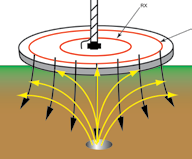 Loading... Please wait...
Loading... Please wait...SEARCHCOIL BASICS
The searchcoil is a vital part of your metal detector. It is the flat, typically circular disk, which generates a magnetic field and senses metallic targets in the surrounding environment. It is located at the end of the stem and is connected to the control housing via a cable normally wound around the stem. The size and depth of the magnetic field is determined by the shape and size of the searchcoil. Understanding the purposes behind the various sizes and shapes of searchcoils will empower you with the ability to choose the best searchcoil for each application.
|
The transmit coil (TX) creates a
magnetic field while the receive
coil (RX) senses distortion in
this field and signals the control
housing.
|
HOW SEARCHCOILS WORKSearchcoils generally consist of two internal sets of coiled wires, a Transmit Coil (TX) and a Receive Coil (RX). Mono coils can be different in that one coil acts as both the TX and the RX. When the detector is turned on, the TX coil generates a magnetic field in the surrounding space. When a metallic object is within this generated magnetic field, it will create a distortion in the magnetic field. The RX coil will sense this distortion and send a signal to the control housing. A searchcoil’s detection pattern is determined by the combination of the TX’s generated field pattern and the RX’s sensing field pattern.
Download the complete Searchcoils Tech Sheet for a full explanation of the workings of Seachcoils including:
|



